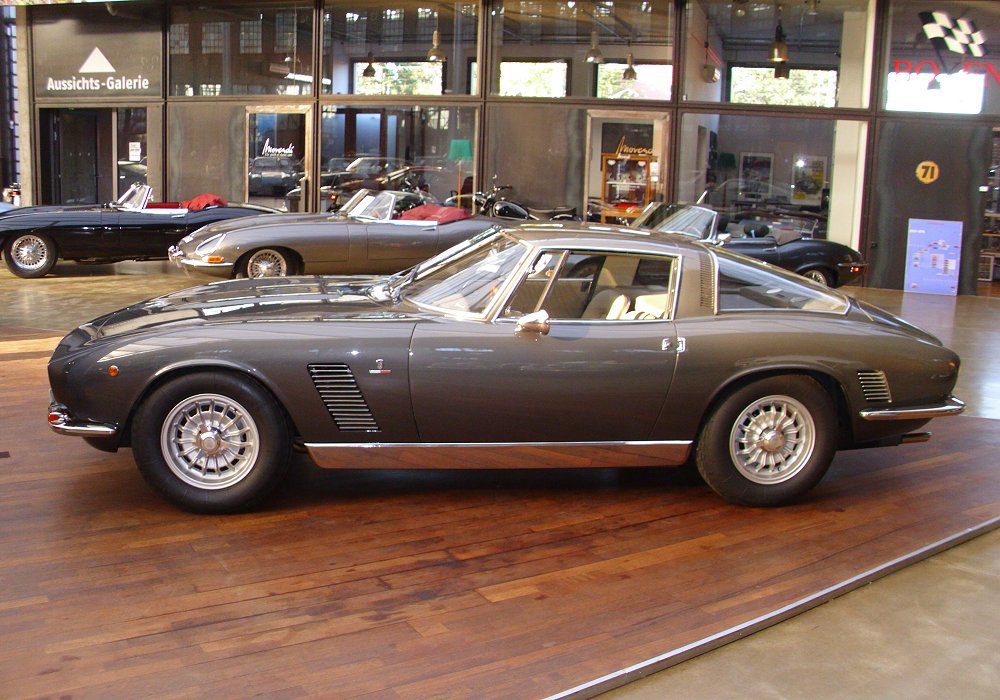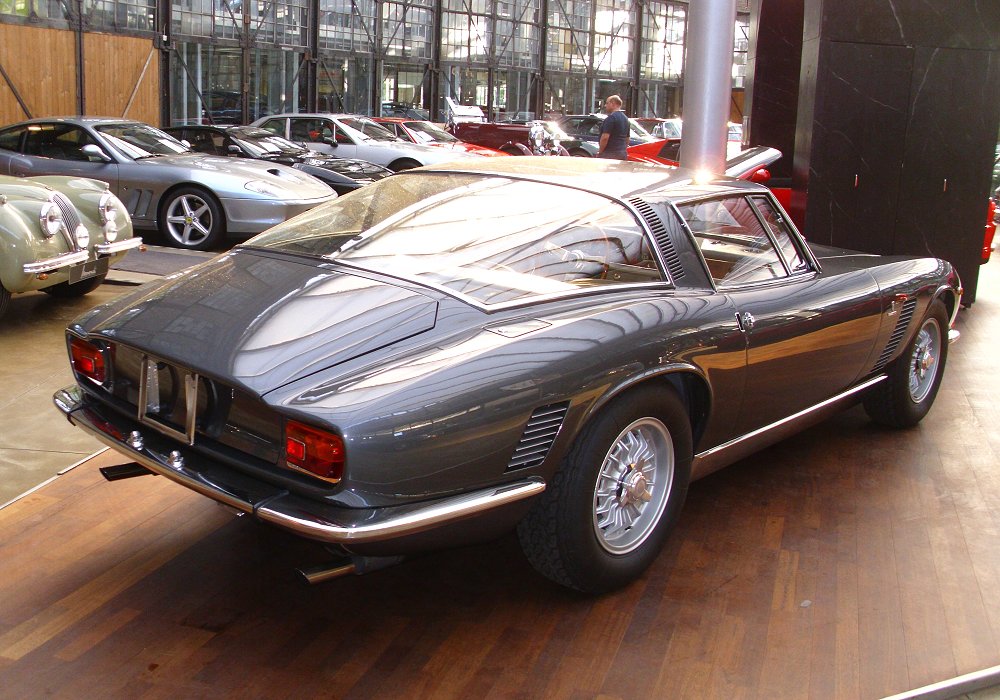Description
The ISO Grifo A3/L was one of the most glamorous and accomplished grand tourers of the 1960s — a car that combined the artistry of Italian design with the power and reliability of American engineering in a way that few others could match. Unveiled in 1963 and entering production in 1965, the Grifo A3/L represented the pinnacle of Renzo Rivolta’s vision for ISO Rivolta: a hand-built, high-speed GT that could rival Ferrari and Maserati for beauty and performance, while offering the comfort, refinement, and durability of a well-engineered luxury car. The result was one of the most admired automobiles of its era — a car whose elegant form concealed formidable power, and whose quiet confidence made it a true classic of the grand touring age.
The origins of the Grifo A3/L lay in a remarkable collaboration between some of the greatest figures in Italian automotive history. Renzo Rivolta, having achieved success with the ISO Rivolta IR 300 and IR 340, wanted to create a smaller, more sporting car based on the same engineering principles: a strong chassis, American V8 power, and Italian bodywork of impeccable taste. To develop it, he turned once again to engineer Giotto Bizzarrini, the former Ferrari designer and architect of the 250 GTO, and to the young Giorgetto Giugiaro, then working at Bertone. The designation “A3/L” stood for “Autotelaio 3 / Lusso” — literally “Chassis 3 / Luxury” — reflecting the car’s intention as a luxurious grand tourer, as distinct from Bizzarrini’s parallel project, the ISO A3/C, which was conceived as a racing version.
Under its graceful aluminium bodywork, the ISO Grifo A3/L was a technical masterpiece. Bizzarrini’s chassis was a shortened, stiffened evolution of the ISO Rivolta platform, featuring a pressed-steel monocoque structure with box-section reinforcements for exceptional rigidity. The front suspension used unequal-length wishbones and coil springs, while the rear employed a de Dion axle with twin trailing arms, a Watts linkage, and inboard rear disc brakes — a sophisticated layout that provided both comfort and sharp handling. Four-wheel disc brakes and rack-and-pinion steering ensured precision and safety at speed, while the car’s near-perfect weight distribution made it exceptionally stable. This blend of strength and balance gave the Grifo a character all its own: a car that could devour Alpine passes with the poise of a racer, yet cruise across continents in hushed refinement.
Power came from the proven Chevrolet 327 cubic inch (5.4-litre) small-block V8, sourced from the Corvette. In standard tune, the engine developed 350 horsepower, while optional high-performance versions produced up to 365 horsepower. Coupled with a four-speed Borg-Warner manual gearbox — later joined by optional five-speed ZF and automatic units — the Grifo delivered astonishing performance for the mid-1960s: 0–100 km/h (62 mph) in around six seconds and a top speed exceeding 250 km/h (155 mph). Yet what impressed most was the engine’s effortless torque and refinement; the Chevrolet V8 gave the car immense flexibility, allowing relaxed high-speed cruising or thrilling acceleration at will. ISO’s meticulous assembly and careful tuning ensured that each Grifo felt as solid and polished as a luxury limousine, despite its raw power.
Giorgetto Giugiaro’s styling for Bertone was a triumph of proportion and restraint — one of the defining designs of the 1960s. The Grifo’s long, sculpted bonnet, short rear deck, and low, wide stance gave it an unmistakably athletic profile, while the clean beltline and subtle curves expressed both power and elegance. The front end featured a distinctive oval grille flanked by covered headlamps, while the gently tapering tail concluded in thin, horizontal tail lights that echoed the car’s purposeful simplicity. The design managed to appear both muscular and refined — as though carved from a single piece of metal — and it remains one of Giugiaro’s most admired works. The Grifo’s bodywork was hand-built by Bertone, each panel fitted with the precision of a tailored suit, giving the car a presence that few contemporaries could equal.
The interior of the A3/L continued the theme of luxurious understatement. The cabin was beautifully appointed, with deeply contoured leather seats, polished wood veneers, and fine switchgear. The dashboard carried a full complement of Veglia instruments set within a symmetrical wood fascia, while the centre console housed the gear lever and secondary controls within easy reach. The large, thin-rimmed wooden steering wheel gave excellent feedback, and visibility was superb thanks to the car’s slim pillars and low dashboard. It was a cabin designed for long journeys — elegant, comfortable, and exquisitely crafted, yet free from unnecessary ornamentation. Unlike many exotics of its era, the Grifo was practical, with usable luggage space and a refinement that allowed it to serve as a genuine daily driver for the well-heeled enthusiast.
On the road, the ISO Grifo A3/L delivered a driving experience that blended the best qualities of European and American engineering. The V8 engine’s deep, effortless rumble contrasted with the precision and composure of the Italian chassis, producing a sensation of boundless power harnessed by grace. The car could surge forward with a wave of torque in any gear, yet remained whisper-quiet at high speeds. Steering was direct and communicative, the suspension supple yet controlled, and the brakes powerful and progressive. Contemporary testers praised the Grifo’s combination of refinement and pace, calling it “the thinking man’s supercar” — faster than most Ferraris of its time, yet easier to live with, and more understated in its beauty.
When production began in 1965, the Grifo quickly became a symbol of sophisticated performance. It appealed to the discerning few who valued craftsmanship and balance over ostentation. Owners included business magnates, film stars, and racing drivers, all drawn to its blend of style and substance. ISO’s meticulous build quality ensured that every car felt solid and enduring, and the reliability of the American V8 made it far more usable than its Italian rivals.
Over the following years, the Grifo range would expand to include higher-powered variants — including the fearsome Grifo 7 Litri with a 7.0-litre Chevrolet engine and later the Grifo Series II with its revised nose — but the A3/L remained the purest expression of the original concept. Only around 330 examples were built between 1965 and 1970, each hand-assembled at ISO’s Bresso factory near Milan.
Today, the ISO Grifo A3/L stands as one of the most beautifully resolved GTs of the 1960s — a car that unites the artistry of Giugiaro, the engineering brilliance of Bizzarrini, and the vision of Renzo Rivolta in one timeless creation. Collectors prize it for its combination of elegance, power, and reliability, and it remains one of the few Italian exotics of its era that can be driven with complete confidence even today.
The ISO Grifo A3/L was, in every sense, a masterpiece of the golden age of motoring. It was a car of intelligence and restraint — an expression of speed rendered through grace. With its perfect proportions, magnificent engine, and flawless engineering, it remains a lasting testament to ISO Rivolta’s ambition to build the ultimate grand tourer: a machine that could cross continents at a whisper and arrive in splendour.


